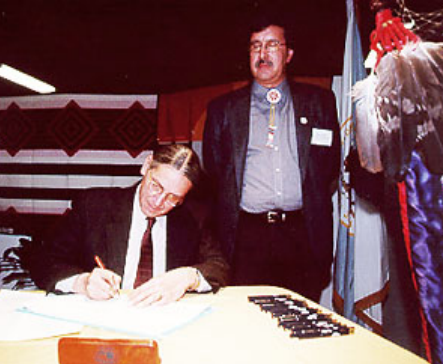You are viewing ARCHIVED content published online before January 20, 2025. Please note that this content is NOT UPDATED, and links may not work. Additionally, any previously issued diversity, equity, inclusion or gender-related guidance on this webpage should be considered rescinded.
On a chilly, overcast day, leaders from twenty-nine tribal nations stood next to Bureau of Indian Affairs officials, a pen was put to paper and a historic agreement establishing the first government-to-government consultation policy between the BIA and the tribal nations was signed on December 13, 2000 in Seattle, Washington. In a ceremony that involved traditional singing and drumming to honor the participants and to call upon the Great Spirit to bless the intent of the agreement, the idea of an open process that creates a better and more efficient consultation with the tribes is recognized as essential to the concept of Self-Governance. Although the relationship between the tribes and the Bureau of Indian Affairs has often been strained in the past during the creation of federal regulations many saw this as a new beginning. “This document is rooted in the centuries before us”, said Collen Cawston, Chairperson, Coville Business Council. “Let it become a living document and that it benefits our people and let us seize the opportunity that is before us.
“A process that is open and up front makes for a more efficient consultation”, said Kevin Gover, Assistant Secretary-Indian Affairs. “This policy was something I wanted to make sure was accomplished before my time was done at the BIA”.
“The consultation guidelines will assist in reducing the hard feelings that sometime arise during the process of developing regulations”, said Sharon Blackwell, deputy commissioner-Indian Affairs. It’s good to have such guidelines in place to assist us in our efforts to make sure the tribes are involved as equal partners”.
The consultation policy calls on the BIA to communicate with tribes as early as possible on any federal action the bureau may take which affects the tribes. It sets forth appropriate guidelines that are understood and adhered to by all parties. The policy also deals with how tribal comments will be handled, how work assignments will be allocated and schedules set, how the consultation process will be designed, and the length of the consultation process. The policy also explains how a federal action will be implemented, how bureau employees will be educated on the consultation process, and the procedure for monitoring the performance of the bureau.
The idea to establish a consultation policy was started back in the fall of 1998 during the NCAI Executive Council Winter Session held in Washington, D.C. The Assistant Secretary Indian Affairs sought a workgroup made up of participants form the National Congress of American Indians. The workgroup comprised of tribal leaders from the 12 BIA regions held four meetings through out the year to draft a policy that was then sent to the Bureau for their input. The Co-chairs of the workgroup was Bob Chicks, President, Stockbridge Munsee Community of Wisconsin and Loretta Tuell, Director, Office of American Indian Trust. “It was a true federal-tribal partnership”, said Tuell. “Everyone wanted to make sure that all perspective was expressed in the agreement”.
For Immediate Release: December 15, 2002


